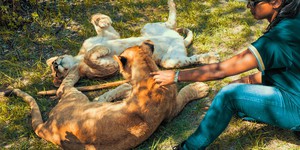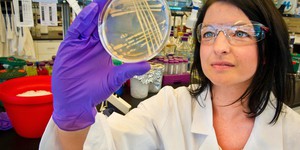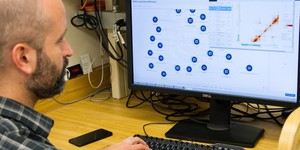Abstract
Humans are complex creatures, but do we have the biggest genome? All living things, from humans to worms to bacteria have genomes. In this experiment you will compare the genome sizes of different organisms to find out who has the smallest and the largest genomes. Where will we fit in?Summary
Objective
In this experiment you will find out how big the genomes of different organisms are and determine which organisms have the largest and smallest genomes.Introduction
All living things come with a set of instructions stored in their DNA, short for deoxyribonucleic acid. Whether you are a human, rat, tomato, or bacteria, each cell will have DNA inside of it. DNA is the blueprint for everything that happens inside the cell of an organism, and each cell has an entire copy of the same set of instructions. The entire set of instructions is called the genome and the information is stored in a code of nucleotides (A, T, C, and G) called bases. Here is an example of a DNA sequence that is 12 base pairs long:
The information stored in the DNA is coded into sets of nucleotide sequences called genes. Each gene is a set of instructions for making a specific protein. The protein has a certain job to do, called a function. Since different cells in your body have different jobs to do, many of the genes will be turned on in some cells, but not others. For example, some genes code for proteins specific to your blood cells, like hemoglobin. Other genes code for proteins specific to your pancreas, like insulin. Even though different genes are turned on in different cells, your cells and organs all work together in a coordinated way so that your body can function properly.
Every individual has its own DNA code, but how can a code with only four letters be unique? It is hard to imagine how a code with so few parts can hold so much information. The key is that the longer the code is, the more unique sequences there can be. For example, the human genome is approximately 3 billion base pairs long and has approximately 20,000–25,000 genes!
In this experiment, you will look up the genome sizes of different types of animals to find out how big they are. But, how is the size of a genome measured? The size of the genome can be measured by quantifying how much DNA is in the nucleus of the cells of an animal. The larger the genome is, the more DNA will be in the nucleus. The nuclear DNA is measured in picograms (pg), which is a very small, microscopic measurement. One picogram is equal to one trillionth of a gram! The size of a genome in picograms is called the C-value, and is used to compare the relative sizes of genomes from different species.
You will use the online Animal Genome Size Database at http://www.genomesize.com to look up the C-value of different species. Since this database uses the scientific name, and not the common name for each species, you can use the Animal Diversity Web at http://animaldiversity.org to get more information about the species you choose. After collecting the genome sizes of different animals, who will have the biggest genome?
Terms and Concepts
To do this type of experiment you should know what the following terms mean. Have an adult help you search the Internet, or take you to your local library to find out more!- Organism
- Genome
- DNA Sequence
- Base Pairs
- C-value
- Picograms (pg)
- How big is my genome?
- How big is the genome of my favorite animal?
- How big is the biggest genome? The smallest?
Bibliography
- This is the website you will use to look up the genome sizes of different animals:
Gregory, T.R. (2007). Animal Genome Size Database. Retrieved June 6, 2007. - The Animal Diversity Web is a great place to get information about different animals. Use this site for this experiment to look up a scientific name, see a photo or learn where an animal lives:
Myers, P., R. Espinosa, C. S. Parr, T. Jones, G. S. Hammond, and T. A. Dewey. (2006). The Animal Diversity Web. University of Michigan Museum of Zoology. Retrieved June 6, 2007. - At the GEEE! in Genome site you can learn about what genomics means to you:
CMN. (2006). The GEEE! in Genomics. Canadian Museum of Nature. Retrieved June 6, 2007.
Materials and Equipment
- Computer with Internet connection
- Lab notebook
Experimental Procedure
- Go to the Animal Genome Size Database at http://www.genomesize.com to begin your experiment.
- To get an idea of the types of animals that are in the database, watch the upper left-hand corner of the web site. You will see images of different animals every 30 seconds or so. Just below the image you will see the scientific name of the animal in italics, and the C-value of the genome size in picograms (pg).
- If there is a scientific name you do not recognize, you can look for more information from the Animal Diversity Web at http://animaldiversity.org (like a common name or a photo).
- Now that you are familiar with the data, you need to make a data table for your experiment:
Common Name Scientific Name Category (Bird, Mammal, etc.) Genome Size, C-Value (pg) - Browse through the database of animals and write down any interesting results in your data table. You can conduct your experiment in several ways:
- Choose your favorite animals and find them in the database.
- Focus on one group of animals (like reptiles) and compare their genome sizes.
- Choose very different types of animals and compare genome sizes.
- Try looking for the extremes! Find the largest or the smallest genomes.
- When you are done, make a bar graph of your data. What did you find out? Did your results turn out the way you expected?
Ask an Expert
Variations
- There are many other genomes, besides the genomes of animals. Try comparing the genome sizes of other organisms:
- Plants
- Fungi (yeasts, molds, and mushrooms)
- Protists (single celled eukaryotes)
- Bacteria (prokaryotes)
- Archaebacteria (ancient prokaryotes)
- What organisms have complete genome projects? Which organisms are in the process of being sequenced? Try the Science Buddies experiment Which Animals Have Genome Projects?
Careers
If you like this project, you might enjoy exploring these related careers:









